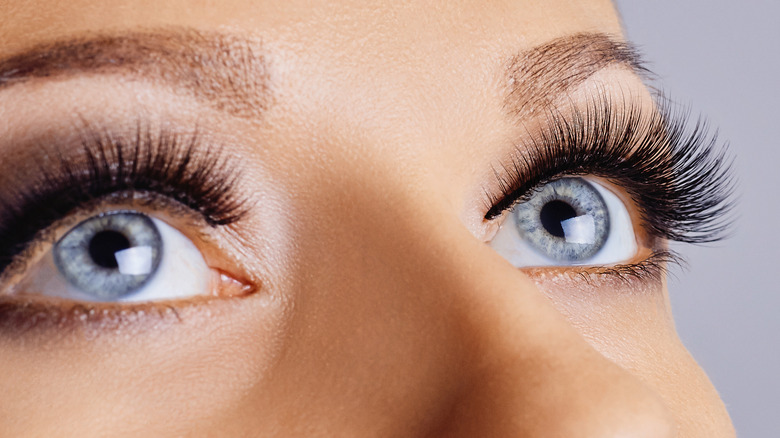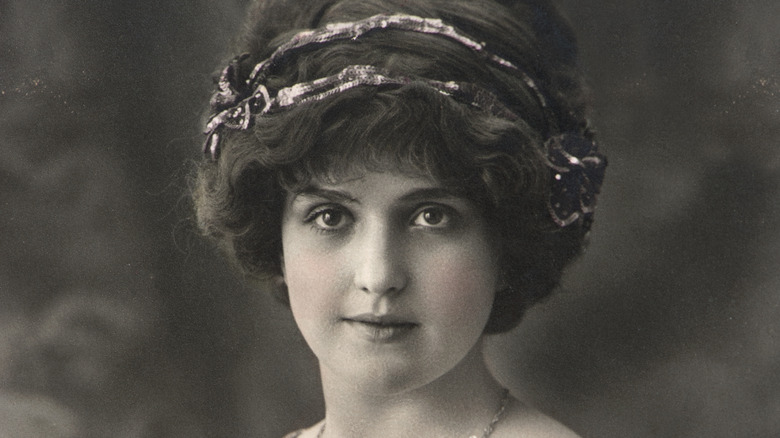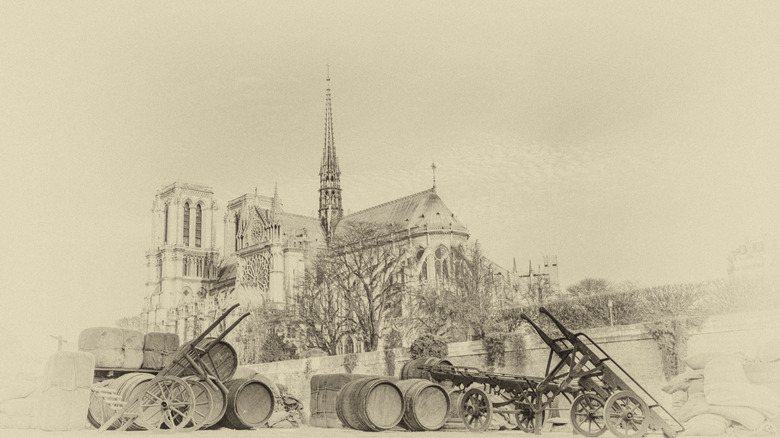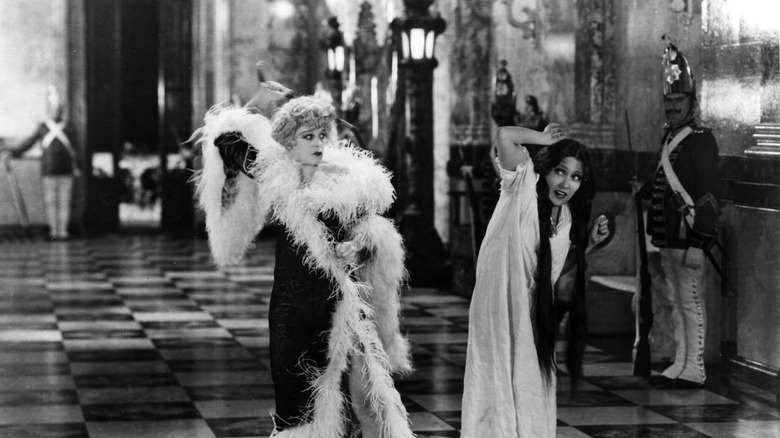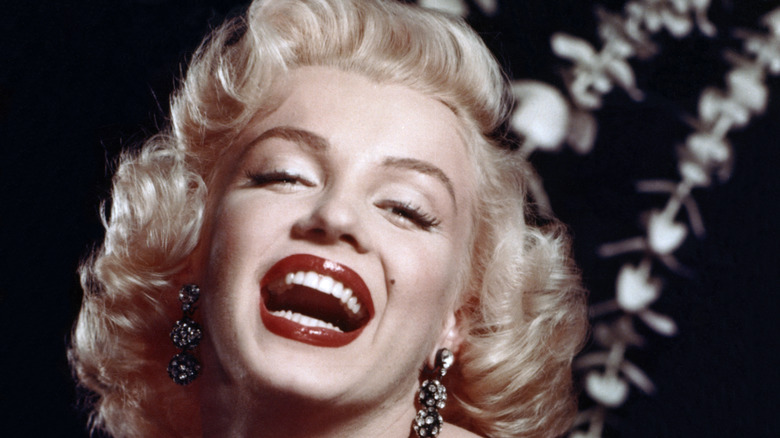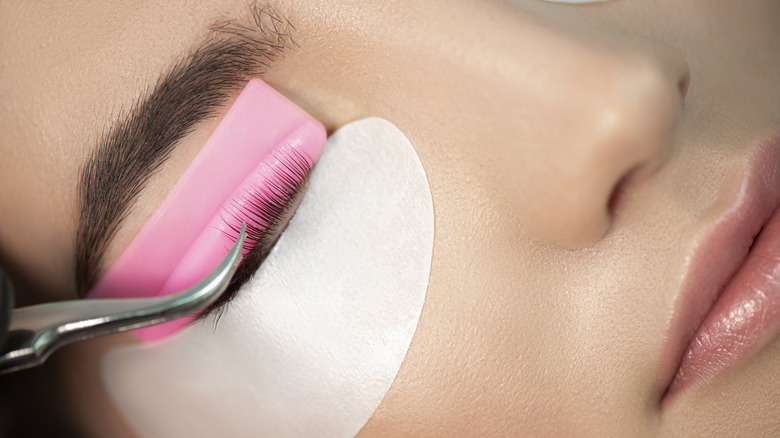Inside The Creepy History Of Fake Eyelashes
While many people looking to lengthen their eyelashes rely on mascara to get the job done, there are some looks that can only be achieved through the application of false eyelashes, or "falsies." Whether you're looking to emulate one of Lady Gaga's famously frilly, colorful, wild lash looks or simply hoping to create photogenic doe eyes for a wedding look, falsies can be your friends.
But where did they come from? One long-held belief about false eyelashes is that they were created by a Victorian Era Parisian prostitute in the 1880's. As it turns out, this story, while intriguing, is in fact entirely and completely false (via Snopes). The true story is actually less believable and much more shocking. If you've ever heard the phrase "pain is beauty," you'll now wonder if the adage is referring specifically to the original process of applying falsies to one's eyes. Fair warning: it's pretty gross.
The horrors of Victorian Age falsies
Perhaps you've heard that the Victorian Era was an interesting time where it came to using human hair for various sentimental and fashionable purposes. For instance: hair jewelry. As a means of keeping someone they loved close to them at all times, people of this time period in western cultures like England and the United States would have jewelry crafted out of the hair of their lovers or their children (via Recollections). Everything from pins to pendants to barrettes were created and worn proudly. Queen Victoria herself is known to have had an extensive collection of hair-based jewelry made from the hair of her beloved Prince Albert.
But likely the most hair-raising use of human hair in this time period (see what we did there?) was as false eyelashes (via Racked). In the late 1800's, women were attempting to glue human hair to their lids in order to create the look of longer lashes. When this ultimately didn't work (the glue often wouldn't hold properly), they took to threading the hair through their lids with a needle.
Are you still with us? If you haven't fainted, then you get to hear a few more details about this greusome process.
What Paris has to do with it
This process was billed to women who could afford it as a common, no-worries beauty treatment and became popular in fashion hubs and wealthy cities like Paris (via Racked). The hair that was used in procedures like this was usually taken from the head of the person wishing to have the surgery, and if it makes you feel any better, the eyelids were cleaned beforehand (it doesn't make us feel any better, either).
If the idea of threading hair through the edges of your eyelids with an actual needle sounds too painful to bear, don't worry: the "professionals" performing this type of surgery would rub cocaine on the eyelid of the patient to help create a numbing effect. Yep, cocaine. Seems like a solid plan all around.
Thankfully, as glue-on falsies became more effective, this violent process of sewing in false lashes fell out of favor. That said, the first successful glue-on falsies were no walk in the park, either.
Falsies in the movies
Initially, needle-free false lashes were generally human hair attached to a bit of gauze or other fabric that was then glued to the eyelid. The glue, however, didn't adhere very well. And while several people had been using them for decades by this point, false lashes made to be glued onto the lid weren't patented until 1911, when Anna Taylor received her patent for her product.
Then, in 1916, lashes were broadcast to the masses when American film director D. W. Griffith wanted the star actress of his movie "Intolerance," Seena Owen, to have "eyelashes brushing her cheeks." In order to achieve this, he asked a wigmaker to glue fake eyelashes to her face. But since the standard glue used for this process wasn't great, as we've mentioned, the wigmaker used spirit gum as glue. This product was not meant to be put near the eyes, and so, as fellow actress Lilian Gish once recalled, Owen once "arrived at the studio with her eyes swollen nearly shut" (via Racked).
Sounds like a good time.
Falsies through the fifties
After this, use of false lashes by actresses in movies became more and more common, and once the public had seen falsies in the movies, the demand for them skyrocketed (via Bustle). One male columnist from this era complained about the increasing number of women who were wearing false lashes, saying, "When a fair young thing looks at you mistily through her long, curling lashes, do not fall for it until you investigate. The long, curling eyelashes may not be hers, except by right of purchase" (via Racked). Yeah, we're rolling our eyes, too.
Throughout the 1920's, designs changed and improved, and by the 1930's falsies had become so mainstream there were ads for them in Vogue (via Bustle). It was in the 1950's that manufacturers of false lashes began making them out of plastic, rather than any type of real hair or other natural fibers, which allowed for mass production, mass marketing, and mass usage. And honestly, the lashes worn by the bombshells of the 50's like Marilyn Monroe weren't really all that different than what we are wearing today.
Modern falsies
So what are we wearing today, exactly, when it comes to falsies? Sure, there are now countless options for lashes and several different adhesives, some of which bill themselves as more gentle than others, and some of which are even magnetic in nature rather than glue-based. But if you are concerned or curious as to what might be in the adhesive you're using for your falsies, try running your product through the Skin Deep Database by the Environmental Working Group (EWG). There you'll find a complete list of ingredients as well as a safety and toxicity rating.
The good news, we suppose, is that whatever you're choosing for your falsie needs, it likely doesn't involve a needle and human hair. Even modern eyelash extensions are generally man-made fibers, and they are attached to each lash, rather to (or through) the lids (via Byrdie). So here's to the brave folks who came before us; we're sorry you were the guinea pigs, but thank you for trying the craziest things so we don't have to.
